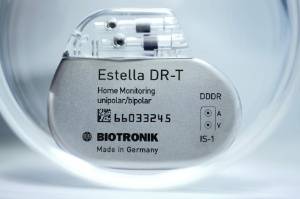Biotronik launches eight new pacemaker models
10 Dec 2010
Biotronik has expanded its range of pacemakers with eight new models in its Estella and Effecta pacemaker series. These are built on Biotronik’s state-of-the-art unified platform technology, which enables the integration of key performance features across all lines.
Estella dual- and single-chamber devices incorporate the company’s pioneering home monitoring system. With the advanced Vp Suppression algorithm, the Estella pacemaker series significantly minimizes ventricular pacing. Vp Suppression switches to ADI mode when intrinsic rhythm is present and operates in DDD mode when intrinsic rhythm is absent. The switching criteria are physician-defined to allow individualized patient therapy.

The Biotronik Estella pacemaker. Photo:
Business Wire.
All models also have ProMRI technology and therefore can be safely used during MRI procedures under specific scanning conditions and when connected with Biotronik ProMRI leads.
“Hundreds of thousands of patients with cardiac pacing devices are indicated for MRI scans at some point after their implantations; however, previous devices were not compatible with this type of diagnostic procedure,” commented Marlou Janssen, Global Vice President of Marketing and Sales.
The Biotronik Effecta pacemaker series features optimized energy efficiency — a 50% reduction of the electrical current consumption within its circuitry and an extension of the pacemaker longevity to more than 10 years.
Effecta also includes the new IRSplus, which promotes the patient’s own intrinsic rhythm and also minimizes unnecessary ventricular pacing. Finally, the Effecta series offers enhanced safety with its automaticity, such as Atrial and Ventricular Capture Control and Auto Lead Check. The former ensures automatic adaptation of the output setting to changes in the atrial and ventricular pacing thresholds.
Beat-by-beat ventricular backup pulses ensure no single beat is skipped. With the latter, lead integrity is automatically and continuously checked by measuring the lead impedance. These measurements do not require additional pacing and are done independently from pacing or sensing phases.